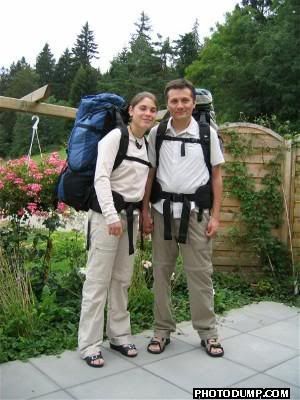Wednesday, March 02, 2005
Laos: The North
Northern Laos is a sleepy mountainous area with an amazing number of ethnic minorities. The remoteness of the area has helped them to preserve their cultures and traditions. Many colourfully dressed women can be seen at the markets, and the buddhist temples and forests are full of animist signs. Travel up there is slow, but the bus journeys across the quaint minority villages and wild landscapes are often as interesting as the stops.
We entered Laos from Thailand by crossing the Mekong river to Huay Xai, a small and busy border town. Lao cargo boats in Chiang Khong, on the thai side of the border:
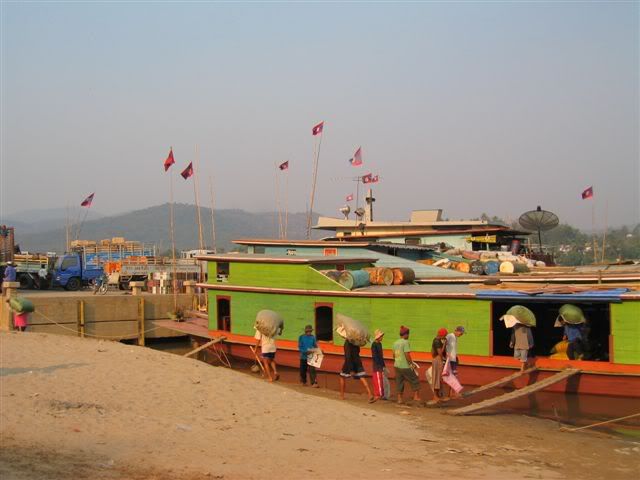
From there, we directly proceeded with a 9 hours bus ride on the unsealed route no3 to the small northwestern Luang Nam Tha province, which boasts around 30 ethnies. Before getting further, we had to stay overnight at Luang Nam Tha, the provincial capital, which, with it's lack of public lighting, looked more like a ghost town. Lenten women at the bus station:
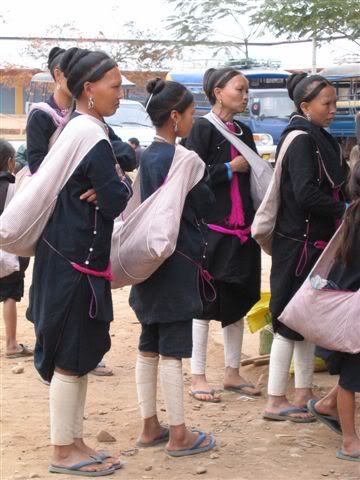
Our first planned stop was Muang Sing, which used to be the biggest centre for opium trade in the Golden Triangle. But nowadays, the market only has legal products and the poppy fields have moved further into the valleys, far from the main roads and the government officials. Internationally funded programs help the villages improve their infrastructure and find alternative sources of revenue. A Hmong woman selling handicraft to a tourist on the morning market...
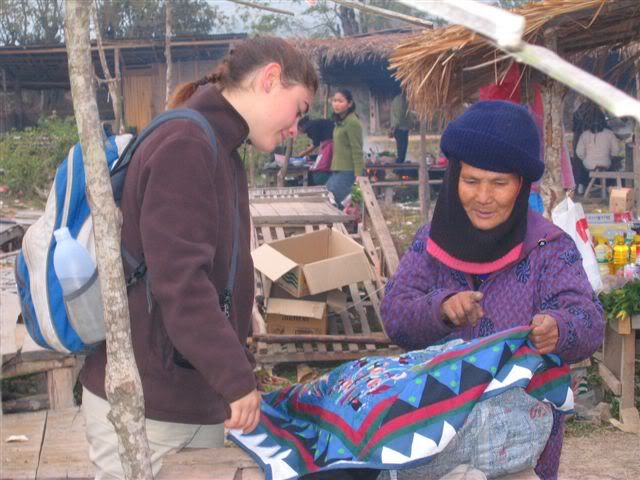
Children playing kataw (kind of foot-volley-ball) in a backyard:
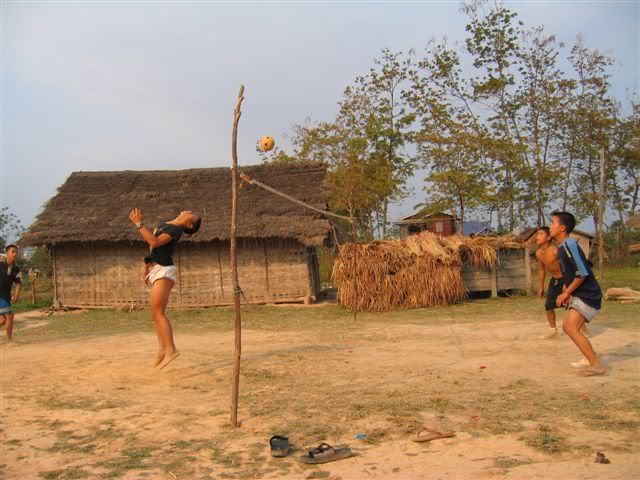
Around Muang Sing, they are many Akha, Hmong, Yao, Thai Neua, and Thai Lu villages. With 2 guides and 3 other travellers, we did an excursion there and stayed for the night in Pawai Kao, an Akha village, where we were warmly greeted with a glass of Lao-Lao (rice wine) and a massage, in accordance with the tradition! Of all the hilltribes, the Akhas are those who most firmly follow their animistic way of life (the Akhazan).
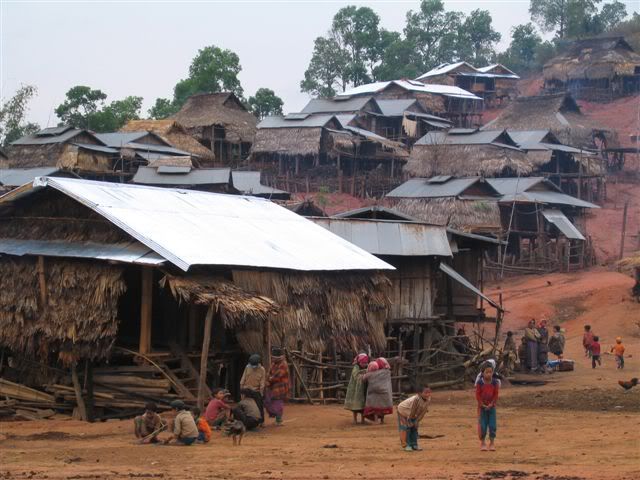
In an effort to minimise the negative impact of tourism, the local trekking company limits the number of excursions and visitors to those places (once a week for a maximum of 6 people in the case of Pawai Kao). But, as they are not so many travellers in the region, the limits are not always reached.
After Muang Sing, we went down to Pak Beng to take a boat to Luang Prabang. It took 2 days by bus to reach Pak Beng, and we had to stay overnight in Udomxai, an unremarkable city from where the chinese built roads of the north radiate. With the planned increase of trade with nearby Yunnan, this town is supposed to grow rapidly in the next years. Unsurprisingly, a strong chinese presence can be felt in Udomxai.
On the way, in the Nam Beng valley:

The scenery on the boat trip from Pak Beng to Luang Prabang didn't disappoint us! The 2 days bus trip to Pak Beng was definetly worth it. It took the slow boat 8 hours meandering through rock formations and sand banks to reach Luang Prabang. View of the Mekong in Pak Beng:
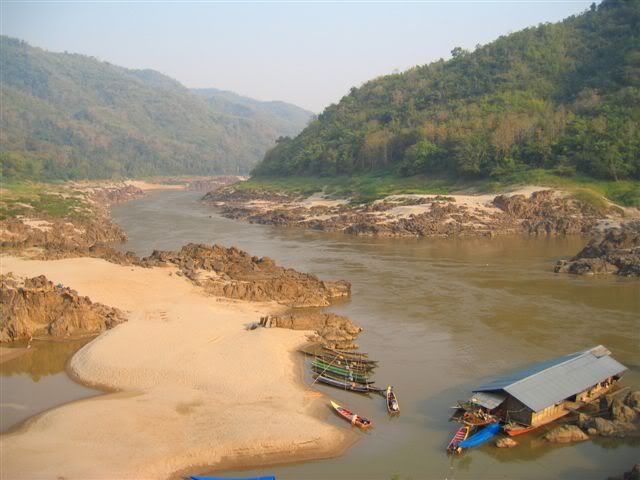
Luang Prabang was the first capital of Lane Xang, the first (and last!) powerful Lao kingdom. It occupied today's Laos and parts of Thailand (the Isan province). Lane Xang had its golden age in the 14-17 centuries. After this, foreign powers (Burma, Siam, France) imposed their rule over Laos until the independance in 1953.
Luang Prabang has kept a strong french colonial touch in the buildings, palaces, cafes... Having lost its political power to Vientiane, the atmosphere stayed very laid back and it didn't undergo much changes since the colonial era.
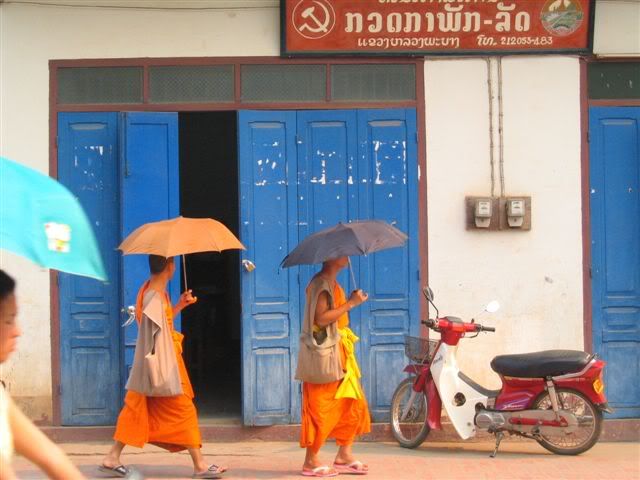
The UNESCO acknowledged Luang Prabang as one of the best preserved old towns in South-East, and put it on the World Cultural Heritage list in 1995. Since then, it has become the main tourist magnet of Laos. But the flow of visitors is still acceptable.
Wat Xieng Thong, an archetypal Luang Prabang style temple:
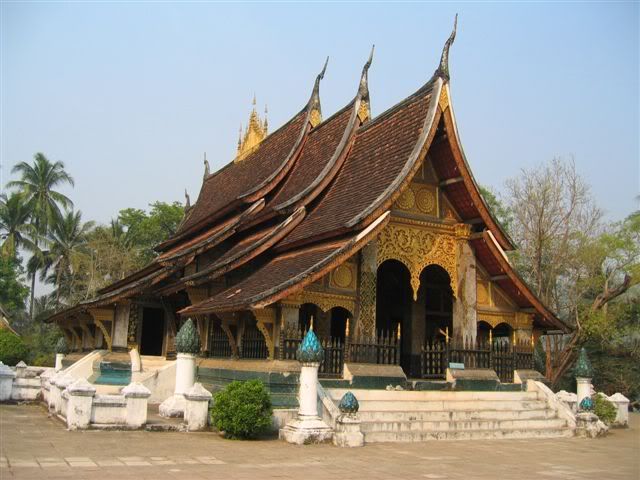
We finished our tour of northern Laos in Phonsavan, in the Xieng Khuang province. A stronghold of the Pathet Lao during the Second Indochina War, this province was carpet-bombed by the USA in a frightening display of fanatism. Between 1964 - 1973, more bombs were dropped over Laos than over Germany and Japan during the Second World War, killing one third of the population.
Traces can still be seen today everywhere in the area. Unexploded ordonnances still claim over 1000 lifes a year in Laos, mostly children who play with the tennis ball sized cluster bomb "bombies" and farmers tilling their land. A metal scrapyard in Phonsavan:

But we didn't come to this area just to see remnants of the war... The main attraction of Phonsavan is the nearby Plain of Jars.

The origin and purpose of those big sandstone urns is still quite mysterious. They are probably 4000 years old. Other smaller sites with similar, but less monumental and cruder jars have been found in Assam (India), Burma and Sulawesi (Indonesia). One of the theories is that they were made by Austro-asian people, who migrated from India over Burma to Laos and then ended in Indonesia. The jars might have been used as repositories for ritual offerings.
Here a picture of us for our parents!
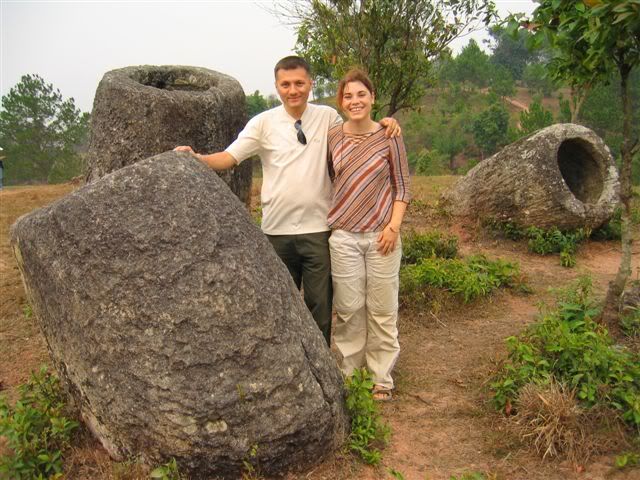
We entered Laos from Thailand by crossing the Mekong river to Huay Xai, a small and busy border town. Lao cargo boats in Chiang Khong, on the thai side of the border:

From there, we directly proceeded with a 9 hours bus ride on the unsealed route no3 to the small northwestern Luang Nam Tha province, which boasts around 30 ethnies. Before getting further, we had to stay overnight at Luang Nam Tha, the provincial capital, which, with it's lack of public lighting, looked more like a ghost town. Lenten women at the bus station:

Our first planned stop was Muang Sing, which used to be the biggest centre for opium trade in the Golden Triangle. But nowadays, the market only has legal products and the poppy fields have moved further into the valleys, far from the main roads and the government officials. Internationally funded programs help the villages improve their infrastructure and find alternative sources of revenue. A Hmong woman selling handicraft to a tourist on the morning market...

Children playing kataw (kind of foot-volley-ball) in a backyard:

Around Muang Sing, they are many Akha, Hmong, Yao, Thai Neua, and Thai Lu villages. With 2 guides and 3 other travellers, we did an excursion there and stayed for the night in Pawai Kao, an Akha village, where we were warmly greeted with a glass of Lao-Lao (rice wine) and a massage, in accordance with the tradition! Of all the hilltribes, the Akhas are those who most firmly follow their animistic way of life (the Akhazan).

In an effort to minimise the negative impact of tourism, the local trekking company limits the number of excursions and visitors to those places (once a week for a maximum of 6 people in the case of Pawai Kao). But, as they are not so many travellers in the region, the limits are not always reached.
After Muang Sing, we went down to Pak Beng to take a boat to Luang Prabang. It took 2 days by bus to reach Pak Beng, and we had to stay overnight in Udomxai, an unremarkable city from where the chinese built roads of the north radiate. With the planned increase of trade with nearby Yunnan, this town is supposed to grow rapidly in the next years. Unsurprisingly, a strong chinese presence can be felt in Udomxai.
On the way, in the Nam Beng valley:

The scenery on the boat trip from Pak Beng to Luang Prabang didn't disappoint us! The 2 days bus trip to Pak Beng was definetly worth it. It took the slow boat 8 hours meandering through rock formations and sand banks to reach Luang Prabang. View of the Mekong in Pak Beng:

Luang Prabang was the first capital of Lane Xang, the first (and last!) powerful Lao kingdom. It occupied today's Laos and parts of Thailand (the Isan province). Lane Xang had its golden age in the 14-17 centuries. After this, foreign powers (Burma, Siam, France) imposed their rule over Laos until the independance in 1953.
Luang Prabang has kept a strong french colonial touch in the buildings, palaces, cafes... Having lost its political power to Vientiane, the atmosphere stayed very laid back and it didn't undergo much changes since the colonial era.

The UNESCO acknowledged Luang Prabang as one of the best preserved old towns in South-East, and put it on the World Cultural Heritage list in 1995. Since then, it has become the main tourist magnet of Laos. But the flow of visitors is still acceptable.
Wat Xieng Thong, an archetypal Luang Prabang style temple:

We finished our tour of northern Laos in Phonsavan, in the Xieng Khuang province. A stronghold of the Pathet Lao during the Second Indochina War, this province was carpet-bombed by the USA in a frightening display of fanatism. Between 1964 - 1973, more bombs were dropped over Laos than over Germany and Japan during the Second World War, killing one third of the population.
Traces can still be seen today everywhere in the area. Unexploded ordonnances still claim over 1000 lifes a year in Laos, mostly children who play with the tennis ball sized cluster bomb "bombies" and farmers tilling their land. A metal scrapyard in Phonsavan:

But we didn't come to this area just to see remnants of the war... The main attraction of Phonsavan is the nearby Plain of Jars.

The origin and purpose of those big sandstone urns is still quite mysterious. They are probably 4000 years old. Other smaller sites with similar, but less monumental and cruder jars have been found in Assam (India), Burma and Sulawesi (Indonesia). One of the theories is that they were made by Austro-asian people, who migrated from India over Burma to Laos and then ended in Indonesia. The jars might have been used as repositories for ritual offerings.
Here a picture of us for our parents!

